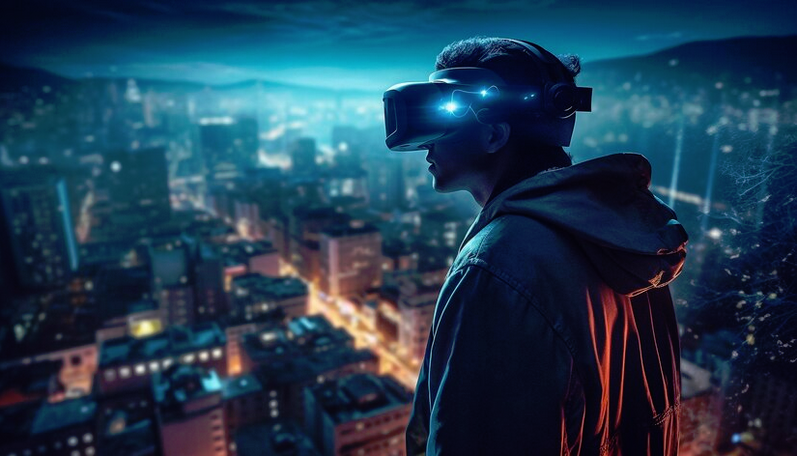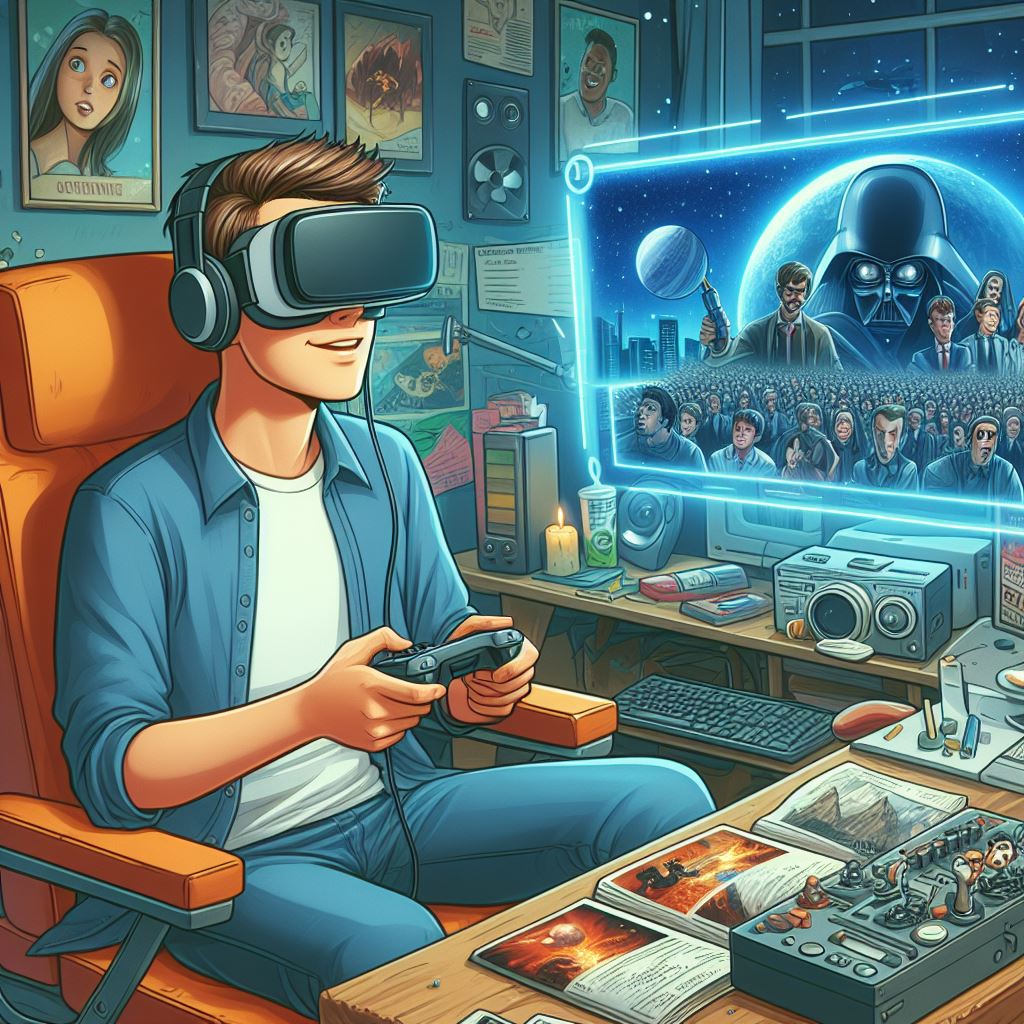Top 10 Video Technology Trends for 2024
Top 10 Video Technology Trends for 2024

Introduction
As we step into 2024, the realm of video technology continues to evolve at a breathtaking pace, reshaping the way we create, consume, and interact with visual media. This article delves into the top 10 video technology trends that are not just influencing the industry but are set to revolutionize our digital experience. From the rise of ultra-high-resolution displays to the integration of AI in video production, these trends highlight a future where video technology transcends traditional boundaries, offering more immersive, interactive, and intelligent solutions.Emerging 4K and 8K Technologies
 The ongoing advancements in 4K and 8K technologies are significantly enhancing the quality of visual content. This leap in resolution is not just a boost for the entertainment industry but is transforming the way we approach broadcasting and content creation.
The impact of these high-resolution technologies extends beyond sharper images, influencing everything from camera design to distribution networks, setting a new standard in the media landscape.
The ongoing advancements in 4K and 8K technologies are significantly enhancing the quality of visual content. This leap in resolution is not just a boost for the entertainment industry but is transforming the way we approach broadcasting and content creation.
The impact of these high-resolution technologies extends beyond sharper images, influencing everything from camera design to distribution networks, setting a new standard in the media landscape.
Advancements in VR and AR
 Virtual and Augmented Reality are reshaping the entertainment landscape, offering immersive experiences that blur the lines between the digital and the real world. These technologies are not confined to gaming and entertainment but are finding applications in everyday life, from virtual shopping experiences to augmented reality in navigation and education.
The integration of VR and AR is paving the way for a more interactive and engaging future in various sectors.
Virtual and Augmented Reality are reshaping the entertainment landscape, offering immersive experiences that blur the lines between the digital and the real world. These technologies are not confined to gaming and entertainment but are finding applications in everyday life, from virtual shopping experiences to augmented reality in navigation and education.
The integration of VR and AR is paving the way for a more interactive and engaging future in various sectors.
AI and Machine Learning in Video
 Artificial Intelligence and Machine Learning are revolutionizing the video industry, automating complex processes like video editing and enhancing video analytics.
These technologies are enabling more efficient workflows, better content targeting, and smarter content creation, ultimately enhancing the viewer's experience. AI's role in video technology marks a significant leap towards more intelligent and adaptive media platforms.
Artificial Intelligence and Machine Learning are revolutionizing the video industry, automating complex processes like video editing and enhancing video analytics.
These technologies are enabling more efficient workflows, better content targeting, and smarter content creation, ultimately enhancing the viewer's experience. AI's role in video technology marks a significant leap towards more intelligent and adaptive media platforms.
Interactive Video Platforms
 The rise of interactive video platforms is transforming viewer engagement. These platforms allow users to interact with content in real-time, offering a more engaging and personalized viewing experience.
The future of interactive media is about creating content that is not just watched but interacted with, offering new possibilities in storytelling and user engagement.
The rise of interactive video platforms is transforming viewer engagement. These platforms allow users to interact with content in real-time, offering a more engaging and personalized viewing experience.
The future of interactive media is about creating content that is not just watched but interacted with, offering new possibilities in storytelling and user engagement.
Cloud-Based Video Services
 Cloud-based video services are reshaping the landscape of content creation and streaming. These services offer numerous benefits, including enhanced collaboration, scalability, and accessibility.
The impact of cloud technology on streaming services is profound, offering more efficient content delivery and enabling a new era of video streaming experiences.
Cloud-based video services are reshaping the landscape of content creation and streaming. These services offer numerous benefits, including enhanced collaboration, scalability, and accessibility.
The impact of cloud technology on streaming services is profound, offering more efficient content delivery and enabling a new era of video streaming experiences.
5G's Role in Video Technology
 The deployment of 5G technology is a game-changer for video technology. With faster streaming capabilities and enhanced mobile video experiences, 5G is facilitating a significant shift in how we consume video content.
Its impact extends from improving the quality of streaming services to enabling more immersive mobile video experiences.
The deployment of 5G technology is a game-changer for video technology. With faster streaming capabilities and enhanced mobile video experiences, 5G is facilitating a significant shift in how we consume video content.
Its impact extends from improving the quality of streaming services to enabling more immersive mobile video experiences.
Video Technology in Education
 The integration of video technology in education is revolutionizing the learning experience. E-learning is evolving rapidly, with video technology offering more interactive and engaging tools for education.
From virtual classrooms to interactive learning modules, video technology is playing a pivotal role in shaping the future of education.
The integration of video technology in education is revolutionizing the learning experience. E-learning is evolving rapidly, with video technology offering more interactive and engaging tools for education.
From virtual classrooms to interactive learning modules, video technology is playing a pivotal role in shaping the future of education.
Cybersecurity in Video Technology
 As video technology advances, so does the need for robust cybersecurity measures. Protecting digital content and ensuring the security of video data has become paramount.
The future of video technology is not just about innovation but also about safeguarding the content and the platforms that deliver it.
As video technology advances, so does the need for robust cybersecurity measures. Protecting digital content and ensuring the security of video data has become paramount.
The future of video technology is not just about innovation but also about safeguarding the content and the platforms that deliver it.
The Future of Live Streaming
Live streaming continues to evolve, with new innovations in live broadcast technology and the increasing integration of live streaming in social media. The future of live streaming is about offering more dynamic, interactive, and high-quality live experiences, both for broadcasters and viewers alike. This trend is revolutionizing the way events, news, and personal experiences are shared in real-time, making live streaming a powerful tool in the digital age.Video Analytics and Big Data
 The fusion of video analytics and big data is transforming how we understand viewer preferences and behaviors. By analyzing vast amounts of video data, content creators can enhance viewer experiences and tailor their strategies more effectively.
This trend not only aids in better content creation but also plays a significant role in marketing and advertising strategies, offering insights that were previously unattainable.
The fusion of video analytics and big data is transforming how we understand viewer preferences and behaviors. By analyzing vast amounts of video data, content creators can enhance viewer experiences and tailor their strategies more effectively.
This trend not only aids in better content creation but also plays a significant role in marketing and advertising strategies, offering insights that were previously unattainable.
Deepfakes and Synthetic Media
Deepfakes and synthetic media are at the forefront of digital innovation, raising both excitement and ethical concerns. As technology becomes more sophisticated in creating hyper-realistic videos, the challenge lies in maintaining authenticity and preventing misuse. The ability to detect deepfakes and understand their implications is crucial in ensuring the responsible use of synthetic media.Video Technology in Healthcare
 In the healthcare sector, video technology is making significant strides, particularly in telemedicine and medical training. With advancements in video conferencing and virtual reality, healthcare professionals can offer better patient care and enhance medical education.
This trend is not just about convenience but is transforming the way healthcare services are delivered and experienced.
In the healthcare sector, video technology is making significant strides, particularly in telemedicine and medical training. With advancements in video conferencing and virtual reality, healthcare professionals can offer better patient care and enhance medical education.
This trend is not just about convenience but is transforming the way healthcare services are delivered and experienced.
The Rise of Mobile Video Content
 The surge in mobile video content is reshaping the media landscape. With the majority of internet users accessing content via smartphones, the focus has shifted to mobile-first content strategies.
From smartphone film making to the creation of content specifically designed for mobile viewing, this trend underscores the growing importance of mobile devices in content consumption and creation.
The surge in mobile video content is reshaping the media landscape. With the majority of internet users accessing content via smartphones, the focus has shifted to mobile-first content strategies.
From smartphone film making to the creation of content specifically designed for mobile viewing, this trend underscores the growing importance of mobile devices in content consumption and creation.
Enhanced Video Compression
 Advancements in video compression technology are crucial in the era of high-definition content. By reducing file sizes without compromising quality, enhanced video compression techniques are ensuring smoother streaming experiences, even with limited bandwidth.
This trend is vital in the efficient delivery of high-quality video content, making it accessible to a wider audience.
Advancements in video compression technology are crucial in the era of high-definition content. By reducing file sizes without compromising quality, enhanced video compression techniques are ensuring smoother streaming experiences, even with limited bandwidth.
This trend is vital in the efficient delivery of high-quality video content, making it accessible to a wider audience.
Virtual Reality Cinematography
 Virtual reality cinematography is opening new avenues in film-making. With innovative techniques and tools, filmmakers are now able to create immersive cinematic experiences, bringing audiences closer to the story than ever before. The potential of VR in movie theaters and home entertainment is vast, offering a glimpse into the future of film-making.
Virtual reality cinematography is opening new avenues in film-making. With innovative techniques and tools, filmmakers are now able to create immersive cinematic experiences, bringing audiences closer to the story than ever before. The potential of VR in movie theaters and home entertainment is vast, offering a glimpse into the future of film-making.
Personalized Video Content
Personalized video content, driven by AI, is becoming increasingly popular. By tailoring content to individual preferences and behaviors, platforms can enhance user experience and engagement. This trend highlights the shift towards more customized and interactive media consumption, where content is not just viewed but experienced in a personalized manner.Top 10 Video Technology Trends for 2024
As we navigate through 2024, the video technology trends highlighted in this article are not just influencing the industry; they are revolutionizing the way we interact with the world. From the immersive experiences offered by VR and AR to the intelligent solutions provided by AI and big data, these trends are shaping a future where video technology is more interactive, immersive, and intelligent. As we embrace these advancements, it's exciting to envision how they will continue to transform our digital landscape.FAQs: Top 10 Video Technology Trends for 2024
How is 5G Technology Impacting Video Streaming?
5G technology is significantly enhancing video streaming by providing faster and more reliable internet connections. With its high data speeds and reduced latency, 5G allows for smoother streaming of high-definition videos without buffering. It also enables more efficient mobile streaming, supporting higher quality content even on the go. This advancement is particularly crucial for live streaming events, where 5G's capacity for handling higher data volumes ensures a seamless, real-time viewing experience.What are the Implications of AI and Machine Learning in Video Editing?
AI and machine learning are revolutionizing video editing by automating time-consuming tasks and enabling more sophisticated editing techniques. These technologies allow for automatic color correction, sound design, and even editing decisions based on predefined rules or styles. They also facilitate object recognition and tracking, making effects and content personalization more efficient. The implications are significant, leading to faster production times, reduced costs, and the ability for editors to focus on creative aspects rather than manual processes.How is Video Technology Enhancing the Educational Experience?
Video technology is transforming education by enabling interactive and immersive learning experiences. It facilitates virtual classrooms, allowing remote learning with the same engagement level as in-person classes. Educational content is more accessible, with video lectures, tutorials, and demonstrations helping cater to different learning styles. Technologies like AR and VR in video bring subjects to life, offering students hands-on and experiential learning opportunities that were previously impossible.What Ethical Issues Arise from Deepfakes and Synthetic Media?
Deepfakes and synthetic media raise significant ethical concerns, primarily around misinformation and privacy. These realistic-looking videos can be used to create false narratives, manipulate opinions, and impersonate individuals, leading to potential political and social consequences. Additionally, there are privacy concerns, as deepfake technology can be used to misuse someone's likeness without consent. The ethical implications necessitate strict regulations and the development of tools to detect and combat malicious use of this technology.How are Advancements in VR and AR Changing the Entertainment Industry?
Advancements in Virtual Reality (VR) and Augmented Reality (AR) are transforming the entertainment industry by creating more immersive and interactive experiences. VR allows users to be 'inside' the entertainment, offering a 360-degree view and interaction with the virtual world. AR, on the other hand, enhances the real world by overlaying digital information on it, offering new ways to experience content. These technologies are being used in gaming, movies, live events, and theme parks, providing unique experiences that go beyond traditional screens.What Role Does Cybersecurity Play in the Future of Video Technology?
Cybersecurity plays a critical role in the future of video technology, as the increasing use of digital video content and platforms also raises the risk of cyber threats. Protecting the integrity, privacy, and accessibility of video content is paramount, especially with the growth of streaming services, cloud-based video production, and AI technologies. Cybersecurity measures are essential to prevent unauthorized access, data breaches, and manipulation of video content, ensuring the safety and trust of both content creators and consumers.Top 10 Video Technology Trends for 2024 an article by Nicole Delgado 2024 | CMO | Explainer Video Company | Animated Explainer Videos For Business
Comments
Post a Comment